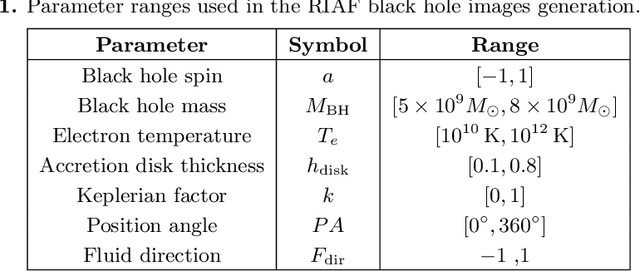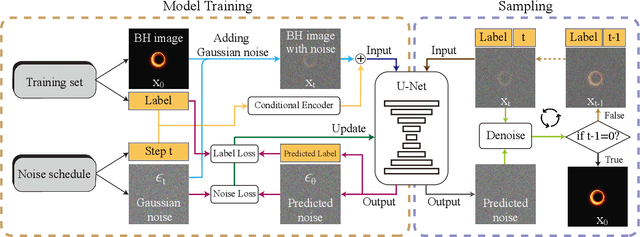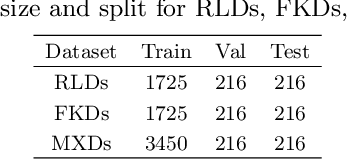Cuihong Wen
BCDDM: Branch-Corrected Denoising Diffusion Model for Black Hole Image Generation
Feb 12, 2025



Abstract:The properties of black holes and accretion flows can be inferred by fitting Event Horizon Telescope (EHT) data to simulated images generated through general relativistic ray tracing (GRRT). However, due to the computationally intensive nature of GRRT, the efficiency of generating specific radiation flux images needs to be improved. This paper introduces the Branch Correction Denoising Diffusion Model (BCDDM), which uses a branch correction mechanism and a weighted mixed loss function to improve the accuracy of generated black hole images based on seven physical parameters of the radiatively inefficient accretion flow (RIAF) model. Our experiments show a strong correlation between the generated images and their physical parameters. By enhancing the GRRT dataset with BCDDM-generated images and using ResNet50 for parameter regression, we achieve significant improvements in parameter prediction performance. This approach reduces computational costs and provides a faster, more efficient method for dataset expansion, parameter estimation, and model fitting.
A Classic-Quantum Hybrid Network Framework: CQH-Net
Dec 03, 2024



Abstract:Deep Learning has shown remarkable capabilities in pattern recognition, feature extraction, and classification decision-making. With the rise of quantum computing, the potential of quantum neural networks (QNNs) in Artificial Intelligence is emerging. However, the intrinsic mechanisms and decision transparency of QNNs remain unclear. In this paper, we propose a classic-quantum hybrid network framework (CQH-Net), which uses traditional machine learning methods for feature extraction and quantizes neural networks for classification tasks. We apply CQH-Net to image classification on public datasets. Experimentally, CQH-Net achieves an average convergence rate improvement of 72.8% compared to classical convolutional networks (CNNs) with identical parameters. On the Fashion MNIST dataset, it reaches a final accuracy of 99.02%, representing a significant increase of 5.07% over CNNs. Furthermore, we explore visual explanations for CQH-Net's decision-making process. Results show that the model effectively captures key data features during training and establishes associations between these features and their corresponding categories. This study demonstrates that quantization enhances the models ability to tackle complex classification problems while providing transparency in its decision-making process further supporting quantum advantages in machine learning.
 Add to Chrome
Add to Chrome Add to Firefox
Add to Firefox Add to Edge
Add to Edge